Today, I expanded my slowly growing glass collection. My 40D came with the 28-135mm, and I use that about 85% of the time. It's a great lens. For Christmas, Santa brought me a lovely 100mm Macro lens [and a sweet 580 EX II Speedlite....guess I was a really good girl last year!]. I bought a cheap 75-300mm Telephoto lens over the holidays, but I wasn't very happy with the results, so I took it back [you get what you pay for, I know, I know]. While purchasing a 50mm at Cord Camera, I asked about a replacement telephoto lens.
Based on the Cord dude's recommendations, I got the Sigma 70-300mm Telephoto to replace the cheapy Canon I returned. So, the Sigma isn't really a high end lens either. I mean, it's not a Canon L or anything....but the guy at Cord thought I'd get better results with it than the other lens, so I am giving it a go. I figure if I'm not happy with the results, then I can always return it.
This is the best shot I got of the moon with the first lens [the cheap-o Canon 75-300mm]. Okay, so it doesn't totally suck, but it just isn't as sharp and clear as I would like. I did everything I should, too....used a tripod, used the delay, shot in RAW, shot in manual, blah, blah.....we'll see how Sigma does next full moon....











1 comment:
Hey,
A suggestion concerning astronomical photography. No conventional lens is going to produce spectacular effects due to the tremendous distances (use an adaptor to attach camera to an astronomical telescope), and secondarily, there is quite a bit of atmosphere to degrade your image - that's why observatories are built on mountaintops.
One other point, you would get more interesting results if you photographed the moon during crescent phases up to slightly past half full. It minimizes the glare, but more importantly, the light from the sun is hitting the surface at an angle, maximizing surface detail and creating more interesting shadow and highlight effects. This is the same reason that camera mounted flashes produce "flatter and more washed out" images than does side lighting, using a key and fill light.
Good luck! Bob
Post a Comment